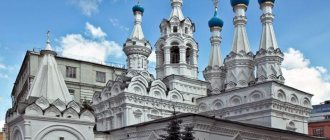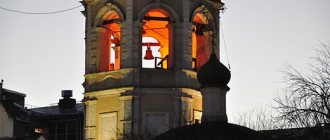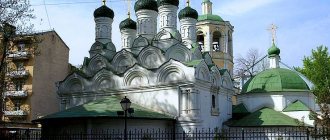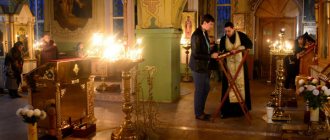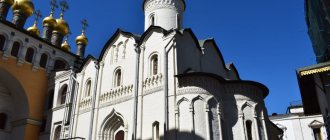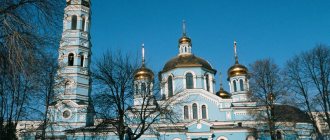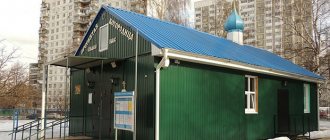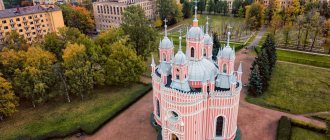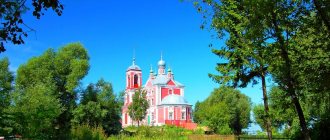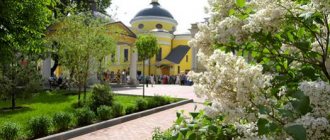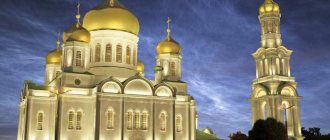| Church of the Nativity of the Blessed Virgin Mary in Stary Simonovo |
Church in honor of the Nativity of the Blessed Virgin Mary in Stary Simonovo
(Moscow diocese)
- Thrones: Nativity of the Blessed Virgin Mary, St. Nicholas the Wonderworker, Blgv. Demetrius Donskoy, St. Kirill Beloezersky, St. Sergius of Radonezh
- Address: Russia, Moscow, st. Vostochnaya, 6
- Official site:
- On the map: Yandex.Map, Google map
A wooden church on this site was erected in 1370 by the Monk Sergius of Radonezh and his nephew Theodore, Bishop of Rostov, as a temple of the small Simonov Monastery.
In 1379, the Simonov Monastery was moved to a new location. There was a monastery cemetery around the temple. In the north-western part of the refectory, the ashes of the holy monks Alexander Peresvet and Andrei (Rodion) Oslyabi, who, with the blessing of St. Sergius of Radonezh, participated in the Battle of Kulikovo (1380), rested under cover. Later, their tombs were built in a new temple (the description of the tombs has been known since 1660). According to local legend, the remains of 32 princes and governors - associates of the Holy Blessed Prince Dimitry Donskoy, who fell on the Kulikovo Field - were buried in two graves at the altar. In memory of all those buried near the temple, a wooden cross has now been erected.
| Church of the Nativity of the Blessed Virgin Mary in Stary Simonovo |
In 1509, the stone church building that still exists today was erected.
In the middle of the 17th century, the old Simonov Monastery was abolished, and the Church of the Nativity of the Blessed Virgin Mary became a parish church. In 1703, in the northeast of the temple, a separate warm wooden refectory with the Church of St. Nicholas the Wonderworker was built (rebuilt in 1734). In 1785-87, a new stone refectory and bell tower were built (rebuilt in 1849-55). In 1870, in the chapel of St. Sergius of Radonezh, a new tombstone of Peresvet and Oslyabi was installed - a masterpiece of cast iron Kasli casting - covered with gold and crowned with three crosses symbolizing the Holy Trinity. Stone slabs describing the monks' feats were replaced with cast iron ones.
In 1894 the temple was painted.
In 1927 or 1929 the church was closed. In the 1930s the church was beheaded. The tombstones of the heroes of Peresvet and Oslyabi were sent for scrap, the tombstones of the monastery cemetery were sawn into curbstones. Windows and doors were broken in the walls. The building housed a compressor station. In 1932, the bell tower was demolished.
In the 1980s The church was transferred to the Historical Museum. Since 1980, it was restored by volunteers, and by 1988 it was fenced off from the plant.
In 1989, the temple was returned to the Russian Orthodox Church.
On September 16, 1989, the chapels of St. Sergius of Radonezh and St. Nicholas were consecrated.
In 1991, a stone belfry was built next to the temple.
Artist O.B. Pavlov painted the Nativity of the Blessed Virgin Mary and the image of the Mother of God “Oranta” on the northern and southern walls using the thermophosphate painting technique. The paintings and interior decoration were restored. In the left aisle of St. Sergius of Radonezh, over the grave of the holy monks Peresvet and Oslyabi, a tombstone made by the sculptor Vyacheslav Klykov was installed.
On June 3, 1993, the main altar was consecrated in honor of the Feast of the Nativity of the Blessed Virgin Mary. The chapel of St. Kirill Belozersky has been restored.
In 2006, the bell tower was restored.
| Chapel of Kirill Belozersky in Stary Simonovo |
There is a Sunday school at the church and a parish Starosimonovskaya library.
On the church grounds there is a chapel in the name of St. Kirill Belozersky, a memorial stone in honor of the significant event of 1397 (the appearance of the Virgin Mary to Kirill), as well as the symbolic grave of the composer Alexander Alyabyev. The actual burial place of Alyabyev is located near the Church of the Nativity of the Virgin Mary, under the building of the ZIL Palace of Culture. Therefore, they decided to install a memorial cross here, where the famous Moscow necropolis was located. On the path leading to the temple, along a concrete fence, fragments of gravestones are displayed, from simply ancient ones to white stone ancient Russian ones. Fragments of bells broken in the 1930s are embedded in the wall of the church. On the territory of the temple there is a marble monument to Saints Peresvet and Oslyabi by sculptor V. M. Klykov, which was previously located in the refectory. On the back of the black obelisk there is attached a large bronze plaque with the words from “Zadonshchina”: “You laid down your heads for the holy churches, for the Russian land and for the Christian faith.”
History of construction
The history of the temple in Putinki goes back almost four hundred years. Modern walls have survived several historical eras unchanged. Church of the Nativity of the Blessed Virgin Mary in Putinki
Temple foundation
At the beginning of the 17th century, a wooden church dedicated to the Nativity of the Virgin Mary appeared outside the Tverskaya Gate of the White City of Moscow. In the historical chronicles of this time it is called a church located “in the Ambassadorial yard in Putinki.” Experts give several versions of the appearance of this name:
- The church courtyard was located near the travel guest palace, where European ambassadors and travelers arrived on their way to the capital of the Russian state.
- Behind the gates began roads leading to different northern cities of Rus', that is, the church was located at a crossroads.
- The third version reflects the urban design features of the historical part of the main Russian city, cut through by many streets and alleys that form something like a giant web.
The wooden church, topped with three tents, burned down in the great Moscow fire of 1648. A year later, construction of a stone cathedral began in its place, most of the funds for which were allocated from the state treasury. In 1652, construction of the church was completed. It was consecrated in honor of the Nativity of the Blessed Virgin Mary.
Tsarist time
The Church of the Nativity of the Virgin Mary, located in Putinki, is the last Russian tented religious building. A year after its consecration, Patriarch Nikon banned the construction of church buildings in the tent style. The chapel of Theodore Tiron and the refectory, added at the end of the 17th century, were decorated in the Baroque style. At the same time, a gatehouse was built, from which a passage led to the bell tower. The west porch, topped by a hipped roof similar in style to the main spiers, was built in 1864. It has not survived in its original form to this day. At the end of the 19th century, the first restoration of the Nativity Church in Putinki was carried out.
Church of the Assumption of the Blessed Virgin Mary in Putinki, 1881. Interesting: believers claim that the church building survived all the shocks and fires thanks to the intercession of the Mother of God. The temple was not damaged during the capture of Moscow by the French, although all the estates surrounding it were looted and burned. After the Bolshevik revolution, the church was not immediately closed. At the end of the 20s, the brethren of the closed Vysoko-Petrovsky Monastery settled there. The doors of God's house were closed to parishioners in 1939. Office space was placed in the building, and later it was given over to the rehearsal space for the management of Circus on Stage. Animal rehearsals took place here. At the end of the 1950s, a second restoration was carried out, which affected only the external appearance of the building. In particular, the 19th century western porch was dismantled. It was replaced by a tented building, similar in style to the buildings of the 17th century. This work was recognized as an example of scientific restoration, which made it possible to preserve the ancient unique building in its original form. It’s interesting: the church, today considered an architectural monument of federal significance, was wanted to be destroyed during the Soviet years. According to legend, the explosion was scheduled for June 22, 1941. For obvious reasons, the event was cancelled. So the war prevented the Soviet government from making a fatal mistake.
Modernity
The temple was returned to the Orthodox Church in 1990. It received the status of a patriarchal metochion. The first modern rector of the church was Hegumen Seraphim. After his tragic death, the parish was headed by Archpriest Theodore Batarchukov, who is the rector of the Church of the Most Holy Theotokos in Putinki to this day.
Interior decoration of the Church of the Nativity of the Blessed Virgin Mary in Putinki By the time the building was returned to the jurisdiction of the Moscow Patriarchate, the interior decoration was almost completely lost. The church was restored using charitable funds, the famous actor Alexander Gavriilovich Abdulov provided great assistance in collecting them.
A little history
On the site of the Church of the Nativity of the Blessed Virgin Mary, a wooden building stood from 1625 to 1648. The building was damaged so badly in the fire that no one dared to undertake its restoration. Thus, the decision was made to build a stone church instead of a wooden one. It was founded in 1649. The main material for construction was brick, for the purchase of which Alexei Mikhailovich himself allocated money (residents of the capital approached the Tsar with a corresponding request several times). The rapid implementation of the grandiose project was facilitated by the Patriarch of Jerusalem Paisius, who ended up in Moscow at that time completely by accident.
The construction of the Church of the Nativity of the Blessed Virgin Mary as a whole cost the state 8 hundred rubles, which in those days was considered a very large sum. The church opened its doors in 1652. The clergy decided to consecrate it in honor of the image of the “Burning Bush of the Mother of God.” The latter is the strongest amulet against fires.
The Church of the Nativity of the Blessed Virgin Mary became the last tented one. A ban on the construction of such was issued by Patriarch Nikon in 1653, 1 year after the opening of the church.
The unique cathedral has been reconstructed many times. In the 17th century, it received an addition in the form of an extension, which was used as a refectory. At the same time, a guardhouse with access to the bell tower, as well as a chapel of the Great Martyr F. Tiron, appeared in the temple. Once again the building was rebuilt in the 18th century, when locals were preparing to welcome Alexander II. For his visit, the temple received a new porch, “facing” the western side (in style it turned out to be identical to the existing one). The next large-scale reconstruction of the Church of the Nativity of the Blessed Virgin Mary took place a little later, at the end of the 19th century. Then the well-known architect Nikolai Sultanov took on it.
Miraculously, the church survived the Soviet era. The government closed it in 1935, however, this decision was not followed by an order to demolish the building. The building began to be used as an office space, and later as a rehearsal base for the Circus on Stage troupe. At this time, the temple was restored several times. In the 1950s, the 18th-century west porch was completely dismantled and replaced by a new one whose style was more reminiscent of the 17th-century style. This work was carried out under the supervision of Nikolai Sveshnikov and Dmitry Sukhov, representing the Academy of Architecture (supervising body).
WE RECOMMEND: Icon of the Resurrection of Christ.
After the collapse of the Soviet Union, the temple was given to the Russian Orthodox Church, which undertook the restoration of the building. This process required considerable capital investment. It was completed, including through donations from public figures (for example, actor A. Abdulov). The cathedral opened its doors to parishioners in 1991. In the patriarchal courtyard (the church received this status after the resumption of work), daily services and festive liturgies are held.
Architecture and interior decoration
To date, the Church of the Nativity of the Blessed Virgin Mary has been completely restored. Its external and internal decoration corresponds to the original design of the 17th century. The unique architectural monument of the 17th century is made in the style of Russian patterning, the distinctive feature of which is the use of many decorative details. The central part of the temple is a quadrangle stretching from south to north, topped with three tents that perform a decorative function. The northern aisle, dedicated to the Burning Bush icon, the patterned bell tower and the western porch are decorated with the same tents. The walls of the church are decorated on the outside with numerous decorative details. The decoration of later extensions to the building is somewhat different from its main part. It is made in the early Moscow Baroque style. The interior design of the church was practically not preserved during Soviet times. The only authentic element is the painting of the central column, depicting revered Orthodox saints. The walls of the temple are decorated with new and restored icons and paintings.
Interior of the Church of the Assumption of the Blessed Virgin Mary in Putinki Among the shrines located in the temple, the following images stand out:
- The icon of the Mother of God “The All-Tsarina” helps cancer patients -
- icon of the Mother of God “Burning Bush”, protecting from fires.
How to get to the Church of the Blessed Virgin Mary in Krylatskoye
The Church of the Nativity of the Blessed Virgin Mary is located in the very center of the Krylatsky Hills park-reserve. The bright blue building of the temple stands out in contrast against the backdrop of a picturesque landscape and green spaces. There are several bus stops along the park's western border. Therefore, getting to the church is not difficult; public transport runs regularly.
The closest stop to the temple is “Church of the Nativity of the Virgin Mary”. Bus routes No. 229, 271, 850, 733, 733K stop here. On the eastern side of the park there is route of minibus No. 829.
How to get there from:
- Art. Krylatskoye metro station - 15 minutes walk to the temple;
- Art. Kuntsevskoye metro station - by bus No. 733. Go to the “Church of the Nativity of the Virgin Mary” stop;
- Art. Polezhaevskoye metro station - by bus number 271. Also;
- Art. Molodezhnaya metro station - by bus No. 732, 829. Also;
- Art. metro station Sokol - st. Krylatskoye metro station - trolleybus number 19. Walk to the church.
Attention! Traveling through the reserve in private vehicles is prohibited. Therefore, it is better to get to the temple by metro. But the access to the park is quite convenient. From the parking lot you need to walk about a hundred meters to the temple along the park path.
The church in Krylatskoye is a wonderful architectural monument, a decoration and highlight of the surrounding park landscape and cityscape. But its main value lies in the unceasing prayer and service to God of the clergy and parishioners of the temple. A majestic church building on the hills, as if soaring upward, attracts not only the views of nearby living people, but also their hearts, striving for the Eternal.
Temple opening hours
The Church of the Nativity of the Virgin Mary is located in Moscow at the address: Malaya Dmitrovka Street, possession 4. Its doors are open daily from eight in the morning to eight in the evening. Services are held on weekends and holidays at 9 a.m. and 5 p.m. Orthodox ceremonies are held in the church, a Sunday school operates, and Orthodox doctors receive consultations. In addition, temple servants provide support to disadvantaged children, orphans and prisoners. Tip: few people visit the church on weekdays, so the excursion trip should be planned on weekdays. This will allow you to calmly enjoy the interior decoration of the temple and feel its spirituality.
Social activities of the temple
Almost from the very first day, an Orthodox library has been operating at the temple. The service here is free for everyone, but registration is required if you have a passport, as in any other similar institution.
The Church of the Nativity of the Virgin Mary is located almost a kilometer from residential buildings
Also, from the very beginning of the church community, Sunday School classes have been held for both children and adults. There are various clubs, for example, drawing for disabled children, a music studio, a sports section and much more, to provide an opportunity for preschoolers, teenagers and their parents who are parishioners of the church to spend quality time.
On Saturdays (11-00 - 13-00) the parish hosts catechetical courses, lectures at which are conducted by clergy and people with theological education. There is an Evangelical Circle; joint conversations and tea parties are held with lay priests. On Sundays, after the early liturgy, classes are organized for adults to study the Law of God.
For reference! There is a charity group at the temple, providing care for hospitals, caring for patients, lonely and elderly people, helping orphanages and prisoners.
On the territory of the temple, an Orthodox psychologist receives everyone. Also, every Wednesday (18-00) parishioners can receive free legal advice. There are several groups at the temple that provide assistance to alcoholics and their families. These are anonymous, non-professional mutual aid communities for people who are faced in one way or another with the problem of alcoholism and drug addiction.
How to get there
The Church of the Nativity of the Blessed Virgin Mary is located in the historical part of Moscow. You can get to it by ground transport and by metro. By metro you need to get to the following metro stations:
- Tverskaya (green line) -
- Pushkinskaya (blue line) -
- Chekhovskaya (gray line).
Having reached the Pushkinsky cinema, you need to turn left. In a few minutes a beautiful white building will appear. The ground transport stop "Pushkinskaya Square" can be reached by buses No. H1 and A. A two-minute walk from it is the Nativity Church. The Church of the Nativity of the Blessed Virgin Mary in Putinki is a beautiful monument of Russian architecture, a striking example of the tent style that dominated Russian architecture until the end of the 17th century. It will be of interest not only to true Orthodox believers, but also to lovers of Russian history.
Church in honor of the Nativity of the Blessed Virgin Mary in Putinki This church, located at the beginning of Malaya Dmitrovka, is the last of its kind. With its construction, an entire architectural era in Russian church architecture ended, and in the 20th century it remained the only one in Moscow that was completed in the form of three tents. Construction cost local residents a very impressive amount. In this part of the street there was an Embassy Courtyard with a travel palace, where foreign ambassadors on their way to the Kremlin stayed. Hence the old name of the entire area - “Putinki”. The wooden church in the name of the Nativity of the Virgin Mary was mentioned for the first time in 1625; there is a version that even then it had a three-tent roof. In 1648 the temple burned down, a year later a new stone building was founded. Local residents, together with the clergy, through the Jerusalem Patriarch Paisius, who was then in Moscow, asked Tsar Alexei Mikhailovich for a stone for construction and money for work. The treasury allocated materials and 300 rubles. This amount was not enough, and after a second appeal the parishioners received another 400 rubles. Money was again not enough; in 1652 an additional 100 rubles were issued. As a result, the church cost 800 rubles, an unthinkable amount for the mid-17th century. But the temple was built unusual. An important architectural feature of the Church of the Nativity of the Virgin Mary in Putinki is its façadelessness: there is no one clearly defined main facade, it can be viewed from any point, it is richly decorated on all sides. Its structure is also non-trivial: the quadrangle stretches from north to south (and not from west to east), the bell tower is placed not from the west, as usual, but from the northeast, next to the three tents of the main part, placed in a row. These tents are not open from the inside, as was originally done in tent churches, but are built on top of the church vaults and serve a purely decorative function. The same can be said about the fourth tent, crowning the chapel of the Burning Bush, erected from the north in the form of a separate cube. The bases of all the drums and the tents placed on them are surrounded by large and small kokoshniks. The Church of the Nativity of the Virgin Mary was consecrated in 1652, and the very next year Patriarch Nikon banned the construction of stone tented churches in Russia, giving preference to five-domed ones. However, a small “loophole” was left for the architects: since the decree did not say anything about bell towers, they continued to be built with hipped roofs until the beginning of the 18th century. So the church on Malaya Dmitrovka became the last tented church in Moscow. At the end of the 17th century. from the southwest, the refectory with the chapel of the Great Martyr Theodore Tiron was expanded, receiving a more modest decor compared to the main part. Another change occurred in 1864, when for the visit of Emperor Alexander II from the west, a new closed porch was added, topped with a tent in the style of the main temple. In 1911, an apartment building was built from the south, partially blocking the view of the church. During the Soviet era, other Moscow churches of similar architecture from the mid-17th century. were either completely destroyed or lost their completion. The building of the Church of the Nativity of the Virgin Mary in Putinki, despite the cessation of services after 1935, was not rebuilt, preserving the decor of the facades. Only the porch was redone again during the restoration in 1957: it became open and now resembled the entrance to the chambers of the 17th century. The interior decoration was destroyed; for many years the church served as a rehearsal base for the Moscow directorate of Circus on Stage. In 1990, the temple was returned to believers; actor Alexander Abdulov provided great assistance in its restoration. It was here that his funeral service took place on January 5, 2008. The church has the status of a patriarchal metochion. In the Moscow outlying settlement, located outside the Tver Gate, a wooden church was built in the 16th century. Previously, the place was called Putinki. Now this is the area of Strastnoy Boulevard and Pushkinskaya Square. The temple was given the name of the Dormition of the Blessed Virgin Mary. The stone church was completed around 1676. At the same time, a refectory was built, and in 1690 a chapel dedicated to St. Nicholas was erected. Towards the end of the 18th century, a bell tower was added.
Churches of the Nativity of the Blessed Virgin Mary
Church of the Nativity of the Virgin Mary in Putinki
The Church of the Nativity of the Virgin Mary in Putinki stands at the very beginning of Malaya Dmitrovka. Magnificent, as if made of snow-white lace, it was built in 1649-1652 - one of the most beautiful and ancient churches consecrated in honor of this holiday, preserved in Moscow. In ancient times, the Putinki tract was located here: here, at the Tverskaya Gate of the White City, two paths diverged - to the cities of Dmitrov and Tver. Here was then the Route Yard for ambassadors and messengers, to which paths led - crooked Moscow-style streets and alleys. Another version explains the name Putinki from the word “web” - small streets and alleys with small Moscow houses scattered on them, lying in the parish of this church, represented a “web” that surrounded the church on all sides.
Originally, there was a three-roofed wooden church built here in 1625. In 1648, it burned down, and the parishioners of the temple, through the Patriarch of Jerusalem, who was staying in Moscow at that time, asked the tsar to allocate money for the construction of a stone church. For the first time in Rus', its chapel was consecrated in honor of the icon of the Mother of God of the Burning Bush, which protects from fires and is therefore so significant for Muscovites. This church is the last building of hipped-roof architecture in Moscow before the famous decree of Patriarch Nikon. Then he banned the construction of tented churches and demanded a widespread transition to the construction of cross-domed churches. This decree would be canceled in the second half of the 17th century after the expulsion of Nikon.
In the same 17th century in Moscow, behind Zemlyanoy Gorod, near Zubovskaya Square, a church was erected with a main altar, consecrated in honor of the icon of the Burning Bush, which gave the name to the lane - Neopalimovsky. The name of the icon comes from Moses’ vision of a burning thorn bush - a bush - engulfed in flames and not burned, symbolizing the ever-virginity of the Most Holy Theotokos. Therefore, the Mother of God is depicted on the icon surrounded by flames.
And although, according to legend, the construction of this church was not connected with the main disaster of the old wooden city - numerous Moscow fires, they prayed at the miraculous icon and sought salvation precisely from the fire that more than once raged in Moscow and left the townspeople as fire victims.
And that's the legend. The list of the Burning Bush icon was in the Kremlin Chamber of Facets. Tsar Fyodor Alekseevich's groom Dmitry Koloshin prayed earnestly in front of her, and when he innocently fell into disgrace with the tsar, he began to ask for help and protection. Then the Queen of Heaven appeared to the king in a dream and revealed to him that this man was innocent. The groom was released from trial by the sovereign and, in gratitude, built a temple in honor of the Burning Bush icon in Novaya Konyushennaya Sloboda, begging the king for a miraculous list. Since then, when there were fires in Moscow, this icon was carried around the houses of church parishioners, and they survived the fire. Muscovites even noticed that in the Neopalimovsky parish fires occurred extremely rarely and were very insignificant, although the entire area remote from the city center was built up with numerous wooden houses. (Neopalimovskaya Church was demolished during Soviet times.)
The little-known, but remarkable for its history, house church of the Nativity of the Virgin Mary in the house of Prince Golitsyn (Volkhonka, 14, behind the building of the Museum of Private Collections) is now destroyed and does not function.
This temple entered the history of Moscow mainly because Pushkin was going to marry Natalya Goncharova here, but was refused by Metropolitan Philaret. Why this happened still remains a mystery to historians. Only the wedding then took place in the parish church of the bride, in the Great Ascension at the Nikitsky Gate.
The Nativity Church itself was a house church and was located on the second floor in the right wing of the existing building. It was directly related to the history of this house and the homeowners, as well as the events that took place here.
The history of the Golitsyn house dates back to the 30s of the 18th century, when they acquired a plot of land behind the Kolymazhny yard for ownership. The project of the house was executed by the St. Petersburg architect S. Chevakinsky, the author of the famous St. Nicholas Naval Cathedral in the northern capital, from whom Vasily Bazhenov studied. In the work on the construction of the Golitsyn house in 1756-1761. he was helped by the young architect I.P. Zherebtsov, the future builder of the beautiful bell tower of the Moscow Novospassky Monastery. In 1766, a church in the name of the Nativity of the Virgin Mary was built and consecrated in the right wing of the house. And soon Catherine the Great herself settled in the house.
The Golitsyn house was passed down from generation to generation. When M.M. Golitsyn-son became the owner, Catherine II turned to him with a request to find her a good and comfortable house in Moscow. The Kuchuk-Kainardzhi peace in the Russian-Turkish war had just been concluded, and the empress was going to Moscow for festivities on this occasion. She did not like to stay in the Kremlin, considering it poorly suited for her. Golitsyn immediately offered the empress his own house.
And then the architect Matvey Kazakov was invited to rebuild the Golitsyn mansion into the Prechistensky Palace. The construction was ready for the New Year, in December 1774. The walls of the modest estate remember the brilliant retinue of Catherine the Great - the empress came to Moscow with her court and son Paul I.
However, she was dissatisfied with the housing: it was cramped and the stoves did not heat the room well. The proximity to the Kolymazhny yard and the stables did not create the freshest air, people froze mercilessly, and the corridors were very confusing. “Two hours passed before I found out the way to my office,” Catherine complained in one of her letters, calling her palace “a triumph of confusion.” Then the wooden buildings of this palace were moved to Vorobyovy Gory and burned there.
According to legend, two icons were kept in the Nativity Church of the Golitsyn house, donated (or left here) by Catherine II in memory of her marriage to Prince Potemkin, apparently wedding icons. It is likely that this legend remained in Moscow’s memory associated with Catherine’s own stay in the Golitsyn palace. Or they thought that she left the owners a royal gift for their hospitality.
In 1779, the Golitsyns returned to their mansion on Volkhonka. When S.M. Golitsyn, trustee of the Moscow educational district, became the owner, he opened an aristocratic salon here. Pushkin visited it and once in the early summer of 1830 he danced here at a ball. Pushkin at that time was already engaged to Natalya Goncharova, and there is evidence that he was going to marry her here. Firstly, historians say, in the house church the payment was less, which was beneficial for Pushkin, who was strapped for funds. Secondly, the attention of high society to the wedding would not be so close.
And yet, permission to marry in the Golitsyn home church was not given. There is a version that it was simply forbidden for people who had nothing to do with them, “from the street,” to get married in house churches, as in ordinary parish churches. And the wedding took place in the bride's parish church.
In the second half of the 19th century, another S.M. lived here. Golitsyn, owner of an art gallery, an ancient library and a collection of antiquities. All this was collected by his father, who dreamed of opening his own museum, but did not have time to fulfill his desire before his death.
In memory of his father, on the first floor of his mansion in 1865, Golitsyn opened a museum, which was called the “Moscow Hermitage”. Here were presented such rarities as ivory vases that belonged to Marie Antoinette, books from the library of the Marquise of Pompadour, paintings by Raphael, Rubens, Poussin, and marble candelabra from Pompeii. And visitors were greeted by a doorman in the uniform of a life hussar.
The museum was open to the public, but curious evidence of how the inspection took place has been preserved. At the owner’s request, only those who came to Sunday services at his home Nativity Church could admire his collection. At the end, everyone went to the princely dining room for Sunday tea, which was attended by the owner, and from there to the museum.
However, just twenty years after the opening of the museum, Golitsyn, who had lost interest in its maintenance, sold his collection at auction. Most of it was bought by the St. Petersburg Hermitage for 800 thousand rubles. It is noteworthy that all the treasures of the Golitsyn Museum remained in their homeland.
In 1877, Golitsyn rented out the first floor of his house for apartments. The museum halls were rebuilt into furnished rooms for rent, and after the reconstruction of the left wing in 1892, they received the name “Princely Court”. A comfortable Moscow hotel has opened in the Golitsyn mansion.
In October 1877, A.N. settled in this house. Ostrovsky, who spent the last years of his life here. When the writer was drawing up a rental agreement, the caretaker of the house seriously began to explain to his wife that before renting out an apartment, he always collects certificates about the moral qualities of the future tenant. Ostrovsky jokingly decided to tell him “some of my virtues - that I am not a drunkard, not a brawler, and will not start a gambling or dance class in my apartment.”
In this house, “Dowry,” “Talents and Admirers,” and “Heart is not a Stone” came from Ostrovsky’s pen. Friends often came to visit him - I.S. Turgenev, D.V. Grigorovich, P.I. Chaikovsky. M.I. lived in the same house on Volkhonka. Tchaikovsky, V.I. Surikov, B.N. Chicherin, I.S. Aksakov, who died here.
In 1902, the Nativity Church was renovated. One of the best Moscow architects of that time, K.M. Bykovsky decorated it in the Gothic style, and the iconostasis in the semi-classical style.
This year became the last year in the history of the Nativity Church being the Golitsyns' home church. The following year, 1903, the house was purchased by the Moscow Art Society and then began to belong to various institutions. It is enough to mention the Moscow City People's University named after. A.L. Shanyavsky, who worked here in 1909-1911. before moving to our own building on Miusskaya Square.
In Soviet times, the former Golitsyn estate was occupied by the Communist Academy under the leadership of historian M.N. Pokrovsky. Then the Nativity Church was closed, and its iconostasis was dismantled and transferred to the church in the village of Alekseevskoye.
Currently, there is a scientific institution here - the Institute of Philosophy of the Academy of Sciences.
Moscow Nativity Convent. Church of St. John Chrysostom. Photo 1882
In Moscow there is also the Nativity Monastery, which was founded in 1386 by Princess Maria Keistutovna, the mother of the hero of the Battle of Kulikovo, Prince Vladimir Serpukhovsky. The magnificent Cathedral of the Nativity of the Blessed Virgin Mary was built in 1501-1505 - it is one of the oldest churches in Moscow. The slender bell tower was erected in 1835 by the architect N.I. Kozlovsky - one wealthy Muscovite donated her funds to it in memory of her beloved son who died early.
In this monastery in 1525, Solomonia Saburova, the wife of Grand Duke Vasily III, was forcibly tonsured a nun. They lived for 20 years, but their marriage turned out to be childless, and the prince wanted to have an heir to the throne. He decided to marry again - divorce was prohibited then, and Solomonia was persuaded to voluntarily enter a monastery, but she resisted. Then she was tonsured by force at the Nativity Monastery. According to an old Moscow legend, this was preceded by Grand Duke Vasily’s vision of a bird’s nest in a tree, when he burst into tears about his childlessness. “Sovereign! - the boyars told him: “The barren fig tree is cut and removed from the grapes.” When he turned to the Greek patriarchs for a blessing for divorce, the primate of Jerusalem, Mark, warned him: “If you marry a second time, you will have an evil child: your kingdom will be filled with horror and sadness, blood will flow like a river, the heads of nobles will fall, the cities will burn.” The Russians decided to do without the help of foreigners and invited Solomonia to voluntarily take monastic vows into a monastery. When she refused, she was forcibly tonsured. Then, according to legend, she cursed the future marriage of the Grand Duke and predicted: “God sees and will take revenge on my persecutor!” From the new marriage of Vasily III and Elena Glinskaya, the future Tsar Ivan the Terrible was born. According to legend, at the minute of his birth, August 25, 1530, at 7 pm, three peals of thunder followed one after another with a blinding flash of lightning.
Solomonia, tonsured under the name of Sophia, remained a nun for more than 17 years and died in 1542. There is a terrible legend that the supposedly newly tonsured wife of the Grand Duke turned out to be pregnant by him “to the horror and repentance” of her ex-husband. She gave birth to a son, named him George and raised him with a dream of revenge: “In due time he will appear in power and glory.” All the legends about the famous robber Kudeyar are associated with his name, who either led the Crimean Khan to Moscow during the reign of Ivan the Terrible, or, on the contrary, allegedly saved the life of his royal brother.
This monastery was not plundered during the Napoleonic invasion, although the French entered it. According to legend, they wanted to tear off the rich frame from the miraculous Kazan Icon of the Mother of God. One of the soldiers rushed to the image, but was immediately seriously injured and could no longer budge. Amazed by this, the rest of the invaders ran out of the monastery.
Corner of a brick monastery wall on the boulevard by artist V.G. Perov portrayed in the film “Troika”.
History of the Assumption Church
The first mention of Putinki dates back to the 14th century . According to legend, at that time there were meadows there that were called Velikiye. Two large highways began there - to Dmitrov and Tver. In the 16th century, one of the country residences of Tsar Vasily III was located in these places. Later it was turned into a Travel Palace to stop foreign ambassadors. Presumably the name Putinki is a derivative of the word path. The fact is that it was necessary to get to the palace by paths, that is, curved alleys and streets. For the first time in chronicles, a church built of wood was mentioned in 1621. It was called the Church of the Assumption in the old Embassy Courtyard, the second name is the Church on Dmitrovka outside the city. In those days, it was famous for its icon depicting the Dormition of the Virgin Mary, exuding myrrh.
Construction of a stone temple
By the end of the 17th century, the wooden temple was either dismantled or burned down on its own. There is no precise documentary information on this matter . Under Tsar Alexei Mikhailovich in 1676, a stone church was built on the site where a wooden church had previously stood. In the 17th century, in the 90s, the first mention of the construction of a chapel in honor of St. Nicholas the Wonderworker on the northern side of the temple appears. The new chapel was made in the Moscow Baroque style. The dome of the main tower of the temple was made in the shape of an apple. This was a rather rare occurrence; there were only two such domes in Moscow. In the second half of the 18th century, the bell tower was erected. The Church of the Assumption of Our Lady gave its name to the lane on which it was located. They called him Uspensky. Later it was renamed Proezzhiy. Towards the end of the 18th century, the main development of the temple property took shape. Buildings were erected on the church graveyard in which the following were located:
- Priest.
- Deacon.
- Sexton.
- Women baking bread.
Shrines of the Church of the Assumption of the Mother of God
The church in Putinki has shrines that are revered by parishioners. There are quite a lot of icons in the small church. Among them are icons depicting:
Particularly revered icon from Constantinople
One of the faces especially revered by Christians is the icon of the Mother of God from Constantinople . One of its lists (copies) is located in the Assumption Church in Putinki. A legend has been preserved about this icon, which says that in ancient times two Greek monks from Constantinople were passing through Staraya Russa. There they served the Divine Liturgy in the cathedral church. In memory of their presence, the monks left in this church a small icon of the Mother of God, which was engraved on a slate board. This miniature face soon became famous for its miracles. After which lists were made from it, which are kept to this day in various churches in Russia, including in the Church of the Assumption in Putinki.
Repair and destruction of the Assumption Church
In 1898, an unknown benefactor donated a large amount for that time to the temple - 6 thousand rubles. This money was used to repair the building and restore the icons. The iconostasis was re-covered with gold leaf, and the walls were decorated with paintings. In 1922, the church was closed, and subsequently it was subject to partial destruction and looting. 34 spools (145 g) of gold, 6 poods and 5 pounds (100 kg) of silver and precious objects disappear from it. The domes of the temple and the bell tower were destroyed, and the entrance to it was blocked with bricks. They also destroyed the apses - buildings adjacent to the main part of the building. In their place, the door and windows were broken through. After the desecration and closure of the church, the building was used as a residential building for many years.
Reduction of territory and return to the fold of the church
Over time, the building was surrounded by extensions , which radically changed the once voluminous composition of the cathedral. The territory of the temple property was greatly reduced. They seized the northwestern part of the territory, on which a three-story house was built in 1927. Currently, it houses the embassy of the African Republic of Benin. In the second half of the twentieth century, the residential building was resettled. A sewing workshop was located there. In 1990, the temple was transferred to the Russian Orthodox Church. After this, its restoration began. In 1991, services were resumed here.
History[edit]
The temple was founded in 1649 after a fire that destroyed the previous wooden Church of the Nativity of the Virgin Mary, and was completed in 1652 under Tsar Alexei Mikhailovich.
As A.V. Chayanov noted, some authors associated the name “in Putinki” with the fact that next to the church there was the Traveling Embassy Courtyard, in which European ambassadors who arrived in Moscow stayed (usually through Novgorod along the Tver Road); others - that the church was located on the “paths” to Dmitrov and other northern cities - at different times, “what is the Tver Gate on Dmitrovka”, “on the old Ambassadorial yard, in Putinki” was added to the name of the temple, until the modern name was established.
The church was built from specially molded brick and included: a quadrangle stretching from north to south, topped with three tents, a lowered rectangular altar volume, a cube-shaped chapel of the Burning Bush, topped with a tent on a drum, a two-tier bell tower and a small refectory adjacent to the quadrangle. churches from the west.
After the completion of the temple in 1653, Patriarch Nikon stopped the construction of tent-roofed churches in Rus'. Thus, the Church of the Nativity of the Virgin Mary in Putinki is one of the last hipped stone churches in Moscow.
At the end of the 17th century, a new wide refectory with a chapel of the Great Martyr Theodore Tiron was added to the temple, including older parts of the church, and a guardhouse was built with a passage to the bell tower. The complexity and fragmentation of the architectural design of the temple was enhanced by external paintings and multi-colored tiles. In 1897, the church was restored by architect N.V. Sultanov.
In 1864, a new west porch of the temple was built with a finish copied from those of the temple itself. This porch was dismantled during the restoration of the temple in 1957 and replaced with a new one, stylized in the 17th century. The restoration was led by architect N. N. Sveshnikov. The work was carried out under the constant supervision of the Academy of Architecture in the person of corresponding member of the academy D. P. Sukhov. The restoration received the highest praise from the Academy of Architecture.
In the 1930s, the brethren of the Vysoko-Petrovsky Monastery served in the church. On June 2, 1935, the consecration of its rector, Archimandrite Alexy (Sergeev), as Bishop of Kashira took place in the church; that same year the parish was closed. After closure, office space was set up in the church building, and then a rehearsal base for the Moscow directorate of Circus on Stage, where dogs and monkeys were trained until the summer of 1990.
In 1990, the temple was transferred to the Orthodox Church, and its restoration began. Hegumen Seraphim (S.P. Shlykov) was appointed rector of the temple, but on the night of February 1-2, 1991, the priest was killed under unclear circumstances.
Services in the temple resumed in August 1991.
Alexander Abdulov made a great contribution to the restoration of the temple, on whose initiative in the courtyard of the theater. Since the late 1980s, the Lenin Komsomol has hosted the “Backyards” festival, the funds from which were directed to the restoration of the Church of the Nativity of the Virgin. Abdulov also became the director of the concert film “Backyards-3, or the Temple must remain the Temple,” the entire proceeds from which were also transferred to the Temple restoration fund. On January 5, 2008, the funeral service of A. Abdulov was held in the Church of the Nativity of the Virgin Mary in Putinki.
Schedule of services
Temple in Putinki
The Church of the Assumption of the Virgin Mary in Putinki is located in Moscow, on Uspensky Lane, in house No. 4. The church is open to the public every day from 10:00 to 19:00, as well as during services. Information about the schedule of services in the Assumption Church is as follows:
Church of the Nativity of the Virgin Mary in Putinki
This church, located in Putinki, is truly unique. It is the only three-tent temple building on the territory of Moscow, the appearance of which has survived to this day. In 1648, the wooden temple was destroyed by fire, but on the site of the previous structure, a new one was erected from stone according to its model. Its uniqueness lies in its lack of façade, that is, from any point of view it does not have a uniformly defined façade due to the non-standard architectural solutions that were used during construction. The Church of the Nativity of the Virgin Mary is a historical architectural monument, but at the same time the temple is active and services are held in it. Service schedule:
- On weekdays, morning services begin at 7:30 am.
- On Saturday, Sunday, and also on holidays, the Divine Liturgy is held from 9-00.
- The All-Night Vigil begins at 6:00 pm.
Cathedral of the Assumption of the Mother of God in Moscow
Another Church of the Assumption of the Virgin Mary in the capital is located on the territory of the Kremlin , on the square called Cathedral. It belongs to the historical and cultural museum-reserve "Moscow Kremlin". The church was built in 1475 - 1479. The development of the project was entrusted to the famous Italian architect Aristotle Fioravanti. This temple was the main cathedral of the Russian Empire until the abolition of the monarchy in 1917. The Church of the Assumption is the oldest building in Moscow that has been completely preserved. The ashes of all the patriarchs of Moscow of the first patriarchal period, with the exception of Ignatius and Nikon, rest in the cathedral.
Miracle of 1941
After the October Revolution, the church standing in the very center of the city could not help but become an eyesore for adherents of the new atheistic government. In 1929, the authorities closed the churches on the territory of the nearby Vysoko-Petrovsky Monastery. At the end of the 1930s, the Nativity of the Virgin Mary Church was closed. There is a legend according to which it was supposed to be blown up on June 22, 1941. If it is reliable, then the church was mystically saved by the beginning of the Great Patriotic War. That day there was clearly no time to blow up the church, and during the years of difficult trials for the country, the attitude of the authorities towards the Church changed for the better.
Today, the Church of the Nativity of the Blessed Virgin Mary in Putinki stands among the most beautiful Orthodox churches in Moscow.
The first capital temple made of stone
The first stone temple on this site was erected at the beginning of the 14th century, during the reign of Prince Ivan I Kalita. In the August days of 1326, in the place where the previous wooden cathedral stood, a new white-stone Assumption Church was founded. It was consecrated in 1327. The Assumption Church was the first built of stone in Moscow. Archaeological research shows that it was a single-domed temple, supported by four pillars, with triple apses. It was built in the image of St. George's Cathedral, located in the city of Yuryev-Polsky. The church was erected in an architectural style characteristic of the 14th century. The masonry consisted of squares of rough white stone. It was combined with smoothly polished decorative architectural elements. The façade of the church was crowned with kokoshniks, and the central tower was crowned with a dome.
Moscow Assumption Cathedral in the 15th century
During the reign of Ivan III the Great, the Moscow state gained strength. The Assumption Cathedral ceased to correspond to the status of a cathedral. The chronicles mention that it became very dilapidated and was no longer repaired. Most likely, a decision had already been made to demolish the old one and build a new stone temple. The construction of the new church, the largest in size for those years, was entrusted to the Russian architects Myshkin and Krivtsov. At the end of April 1471 the first stone was laid. However, the construction could not be completed, since on May 20, 1474, an earthquake occurred in Moscow and the cathedral collapsed. After this, Ivan III invites the Italian architect Aristotle Fioravanti, who completely dismantles what remains of the destroyed temple. At this place, under his leadership, a building is being built on the model of the Assumption Cathedral, located in Vladimir. The Assumption Church is still located on Kremlin Square. The cathedral was consecrated in August 1479, the ceremony was performed by Metropolitan Gerontius.
Laconic architecture
The temple has a laconic and monolithic appearance . The unity of the building is emphasized by the uniform division of the facades using vertical flat projections. Smooth walls are crowned with narrow arcature windows. This is the name given to the rows of decorative false arches on the façade. Apses (lower projections of a building adjacent to the main structure) are not very high. They are covered with pylons from the north and south. The pylons are a tower-like structure in the shape of a truncated pyramid. The cathedral is decorated with five large towers topped with massive domes. Aristotle Fioravanti managed to cope with the most difficult task. He increased the internal volume of the cathedral, which Myshkin and Krivtsov failed to do. The Italian, for the first time in the temple architecture of Rus', used cross vaults with a thickness of 1 brick, as well as metal openings and intra-wall connections. Essentially, he applied reinforcement.
The main idea of the Italian architect
But the main engineering and architectural idea of the Italian master was that he built additional arches behind the iconostasis . Thanks to this, the eastern halls, united by the through passages of the cathedral, in fact became a monolith. Additional arches took on a significant share of the load from the colossal towers of the cathedral. This technique made it possible to build relatively thin round pillars in the western and central parts of the temple. This gave a feeling of unusual lightness of the large structure and its integrity with the main part of the pump. The naos is the central place in the temple where parishioners are present during worship.
Moscow temple in the 15th - 16th centuries
The period from 1482 to 1515 . At this time, the initial painting of the cathedral was completed. The famous Moscow icon painter and fresco master Dionysius took part in the painting of the temple. Later, the church is redecorated, but some fragments of the original painting are preserved. They are the oldest examples of fresco painting of Rus' on the territory of the Kremlin that have survived to this day. 1574 . The Assumption Cathedral suffered from numerous fires, which occurred quite often at that time, but it was constantly restored and updated. After a severe fire in 1574, Ivan IV the Terrible issued a decree to cover the top of the cathedral with gilded copper sheets. The relics of Metropolitan Peter, kept in the church, were moved from a silver shrine to a gold one. In the same year, the crowning of Ivan the Terrible took place in the cathedral, the first in the history of the temple.
Assumption Cathedral in the 17th century
The most significant events for the temple in the 17th century were the following:
- In 1613, the Zemsky Sobor was held here, at which Mikhail Fedorovich, the first of the Romanov dynasty, was elected tsar.
- In 1624, the church vaults were worn out and threatened to collapse. To avoid this, they were disassembled and reassembled according to the modified drawing, using additional reinforcement. They also erected additional girth arches, which increased the strength of the structure.
- In 1625, the Robe of the Lord, presented to Tsar Mikhail Fedorovich by the Shah of Persia Abbas I, was transferred to the Assumption Cathedral.
Events of the 18th - 20th centuries associated with the Assumption Church
A brief chronicle of the events of this time is as follows: Currently, the Cathedral of the Assumption of the Blessed Virgin Mary operates as a museum. It can be visited any day except Thursday, from 10:00 to 18:00. While in Moscow, it is worth visiting such architectural pearls of the architecture of ancient Rus', such as churches dedicated to the Nativity and Dormition of the Mother of God. The Church of the Nativity of the Blessed Virgin Mary in Putinki was built at the turn of the 40-50s of the 17th century. The name of the architect who created the Church of the Nativity of the Blessed Virgin Mary in Putinki remains a mystery. However, it is known that the current temple arose on the site of an earlier one that was destroyed in a fire. Tsar Alexei Mikhailovich contributed to the fact that the shrine rose from the ashes. The Church of the Nativity of the Blessed Virgin Mary in Putinki became the first Russian church, one of the altars of which was consecrated in honor.
Architectural features and interior
The structure of the cathedral turned out to be complex. Its main structure is an oblong quadrangle, the main decorations of which are a trio of tents, small domes, an altar volume, as well as a refectory, a two-level bell tower and a chapel. The latter is completed with a compact tent mounted on a powerful drum. Despite the complex composition, the architectural monument seems openwork, light, and very neat. The craftsmen managed to achieve the corresponding effect, including thanks to small dormer windows topped with small domes. This part of the building contrasts strongly with the large tent ring facing Malaya Dmitrovka Street.
When creating the Church of the Nativity of the Blessed Virgin Mary in Putinki, the architects were guided by the traditional features of the Russian style. The patterning was successfully implemented due to the lush decor, the majestic facade with its neat zakomaras, kokoshniks, platbands, cornices and arcature belt.
Inside the temple, parishioners and tourists will see modern icons, the placement of which in the interior of the building preceded the official opening of the cathedral and the resumption of services in the early 90s. The main shrine of the church was the image of F. Tiron. This icon is adjacent to others, no less beautiful (but not so ancient), donated to the temple by grateful parishioners and foreign Orthodox tourists.
INTERESTING: Cathedral of Christ the Savior in Moscow.
